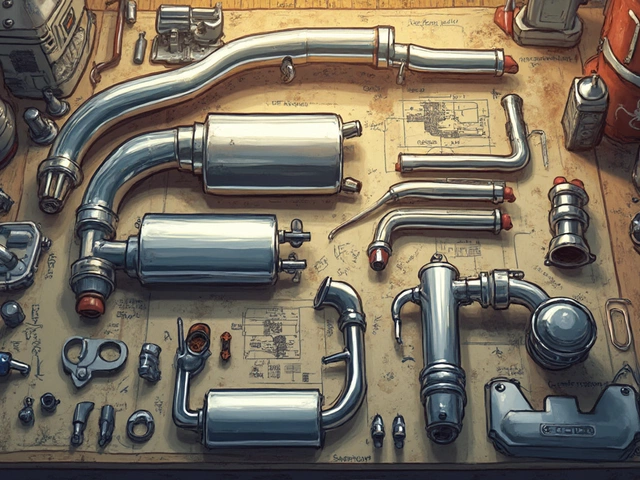If you’ve ever driven a car that jolts you with every pebble in the road or, on the other hand, floats like a couch over speed bumps, you’ve seen that not all suspensions feel the same. The difference between stiffer and softer suspension isn't just about whether your coffee spills on the way to work—it's about how your car connects with the road, how safe you feel in the rain, and even how tired you are after a road trip.
This decision isn’t just for car geeks or racers. The reality is, every driver faces a choice because even stock cars land somewhere on the scale from soft to stiff. Next time you hear someone bragging about tight cornering or complaining their car ‘rides like a brick,’ remember: those are clues to their suspension setup.
Of course, what looks good on paper isn’t always what you want in real life. If you ever rode with my son Finneas after soccer practice, you’d know why a firmer suspension might have me reconsidering my life choices—especially when my back reminds me I’m not twenty anymore.
Let’s break down the differences and see what really matters for your daily drive, your weekend fun, and even your next family road trip.
- The Real Difference: Stiff vs Soft Suspension
- Everyday Driving: Comfort or Control?
- What the Experts Know (And What They Don't Tell You)
- Tips for Picking Suspension That Suits Your Life
The Real Difference: Stiff vs Soft Suspension
So, what really sets a stiff suspension apart from a soft one? It's not just about how bumpy the ride feels. At its core, stiff suspension uses firmer springs and shocks. That means your car doesn’t roll as much in corners or dip as much when you brake hard. Want sharper handling and more control, especially at speed? That’s where stiff suspension shines. You’ll find it in sports cars and cars built for track days.
A stiffer suspension keeps your wheels pressed against the road, which is great for fast, smooth roads or tracks. It cuts down leaning in curves and helps your tires bite harder. Here’s the trade-off: every bump, crack, and pothole sends more shock right into the cabin. After a long day, it gets old fast.
Soft suspension is just the opposite. Car makers put it in most family sedans, SUVs, and minivans. It uses softer springs and lighter damping, so you barely feel small holes and rough patches. Your body won’t lurch when your kid tosses a toy out of the backseat. The car stays comfortable, but there’s more body roll in curves and a bit of squishiness if you push hard. Emergency maneuvers can feel a little sloppy compared to stiffer setups.
Here’s an easy comparison:
- Stiff = better cornering, stable at high speeds, rougher on bad roads
- Soft = super comfy, smoother on bumps, less sharp in corners
Carmakers design suspension to match what the car is meant for. Sports cars go stiff. Big comfy SUVs go soft. Neither is “better” for everyone—it just depends on what you want from your ride and where you drive the most.
Everyday Driving: Comfort or Control?
Choosing between a stiff and soft suspension isn’t just about the tech; it’s about how you want your car to feel every time you take it out. Think about city potholes, speed bumps, and those long stretches of highway. If your car rocks every time you hit a pothole, you probably have a softer suspension. If you feel practically every crack in the pavement, your setup is on the stiffer side.
Softer suspension shines when you’re driving daily—especially over rough roads. You get less cabin vibration, which means less road noise and fewer complaints from the back seat (especially if you’ve got kids or pets). It also helps your car stay grippy over uneven surfaces. That’s because tires spend more time in contact with the road, which helps in rain and on bumpy streets. There’s a reason most family cars and sedans have a softer ride.
On the flip side, stiffer suspension gives you better control, especially around corners and at higher speeds. If you love taking winding roads a bit quicker, you’ll notice the difference right away. Your car doesn’t lean much, and you get a more direct connection to what’s happening under the wheels. Sports cars and performance models usually have this setup, sometimes at the cost of comfort.
But here’s a tip: Too much stiffness on daily commutes quickly gets old. Most people enjoy a stiffer feel for about five minutes—the first time they hit an expansion joint at speed, reality sets in. Bouncing over every crack might look cool to your friends, but your spine (and your passengers) probably won’t be impressed.
If you’re deciding for family use, regular commuting, or you just want less drama from the back seat, a softer setup suits daily life better. But if you crave tight road feedback or you only drive on smooth roads, a stiffer suspension might be your thing. Just remember—there’s no one-size-fits-all. Try different cars if you can, and pay attention not just to how the car feels, but how you feel after your drive. Comfort or control? It’s all about what matters to you every single day.

What the Experts Know (And What They Don't Tell You)
If you’ve ever listened in on mechanics at the shop or tuned into real driving pros, you’ll catch them tossing around advice about suspension setups all the time. But here’s the thing: a lot of what they know doesn’t always make it into the advice you find online. Real experts look beyond just buzzwords like "performance" or "comfort." They look at safety, tire wear, and even weather conditions.
One not-so-obvious tip? Stiffer suspension isn’t always better—even for sporty cars. For average roads full of potholes, softer suspension can actually help your tires keep contact with the ground, making you safer. F1 teams spend millions finding the right balance, because too stiff and you lose grip over bumps. That’s the same reason why rally cars are much softer than most folks expect: their tracks are rough and unpredictable.
- Stiff suspensions can boost handling on smooth tracks, letting you corner harder.
- Too much stiffness on bumpy roads can make your car bounce so hard you actually lose traction.
- Softer setups keep your ride comfy, and can improve grip on patchy pavement, snow, or rain.
- But go too soft, and your car can feel sloppy, especially during sudden lane changes or when hauling a heavy load.
There’s also the money side. Softer suspension can extend the life of your car’s frame and interior by soaking up impacts. But stiff setups tend to wear out bushings, mounts, and sometimes even tires more quickly, especially if your daily route is more pothole than pavement.
To keep things clear, here’s a quick breakdown of the differences in how suspension setups affect your ride:
| Suspension Type | Handling | Comfort | Tire Wear |
|---|---|---|---|
| Stiffer | High (on smooth roads) | Low | Higher on rough roads |
| Softer | Lower (cornering) | High | Lower on average roads |
Experts might not tell you, but a perfect setup rarely exists. Most daily drivers benefit from a middle ground—something stiff enough for control but soft enough to keep you and your passengers happy, and your wallet happier at the tire shop. If you’re chasing comfort for your family or drive on busted streets, don’t be afraid to stay on the softer side.
Tips for Picking Suspension That Suits Your Life
Nobody drives the same, and the best suspension isn’t a one-size-fits-all deal. Start with what bugs you most while driving: Do you wince at potholes, or do you hate body roll in corners? Matching your setup to how and where you drive makes everything better.
If your commute means dodging potholes or wrangling gravel roads, a softer suspension seriously saves your spine and keeps your coffee in your cup. But if you’re into sharper steering, like weaving through traffic or you hit the highway a lot, a stiffer setup gives you more control and quicker response. Family hauler? Your passengers might thank you for extra cushion, especially in the back seat.
- Stiffer suspension = more precise handling, less body roll, but at the cost of comfort. Best for folks who enjoy spirited driving or regularly hit winding roads.
- Softer suspension = smoother ride, forgiving on rough city streets and country lanes but can make the car feel floaty during quick maneuvers. Ideal if you’re carting kids or commuting over patchy roads.
How much does it matter? Here’s a quick look at common needs and what most folks end up choosing:
| Driver Type | Road Conditions | Suspension Preference |
|---|---|---|
| City Commuter | Potholes, speed bumps | Softer |
| Weekend Spirited Driver | Twisty roads, highways | Stiffer |
| Family/Kid Taxi | Suburban, school runs | Softer |
| Track Day Enthusiast | Race track, performance focus | Stiffer |
If you can’t decide, there’s no shame in going for adjustable coilovers. These setups aren’t just for racers—they let you tune the ride to your plans, from school runs to canyon carving. Plus, companies like KW, Bilstein, and even OEM upgrades now offer a range of kits for regular cars, not just sports models.
One last heads-up: cheaping out on suspension parts is usually false economy. Cheaper kits often wear out fast or make your car less safe, and most pros recommend sticking to well-reviewed models—even if it costs more up front.
The bottom line? Pick the setup that matches the worst part of your daily drive, and your car (and your back) will thank you. If you’re stuck, talk to a local shop or hop online—owner forums are full of real-world advice tailored to your car and your roads.




